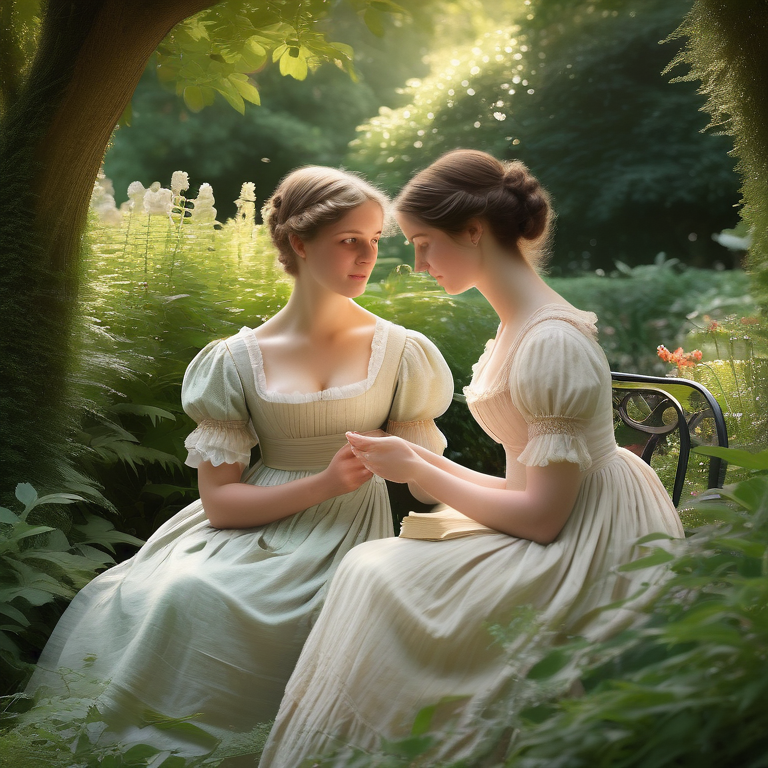Jane Austen’s Insights on Women’s Romantic Desires

Key Highlights
- Jane Austen’s novels offer insights into women’s romantic desires in the Regency era.
- The social context of romantic desires during Austen’s time was influenced by gender roles and expectations, and the socioeconomic necessity of marriage.
- Austen’s portrayal of heroines like Elizabeth Bennet, Elinor Dashwood, Emma Woodhouse showcases different qualities valued in romantic relationships.
- Austen’s personal life and views on love and marriage also shaped her novels and characters.
- Austen’s critique of the marriage market, through satire and social commentary, highlights the economics of marriage and societal norms.
- Austen’s legacy continues to influence modern romance and offers lasting insights into women’s romantic desires in contemporary society.
Introduction
Jane Austen is widely regarded as one of the greatest English novelists, known for her insightful and witty portrayals of society, particularly in the context of romance. Her novels, including Pride and Prejudice, Emma, and the memoir of Jane Austen, rank among the great masterpieces of English literature and provide a window into the world of women’s romantic desires during the Regency era. Through her keen observations and sharp social commentary, Austen offers valuable insights into the complexities of love, marriage, and societal expectations, as published by Oxford University Press in The Complete Novels of Jane Austen for the first time in the United States. Austen’s accomplishments and legacy are often compared to those of her male contemporaries, such as Daniel Defoe, Samuel Richardson, and Henry Fielding, who are credited with laying the foundation for the English novel. However, it is Austen’s distinctively modern approach to portraying unremarkable people in everyday situations, influenced by her interactions with literary figures like Lord Byron, that solidifies her place as a pioneer in the genre, as seen in her satirical work Plan of a Novel, according to Hints from Various Quarters.
In this blog, we will delve into Austen’s works and explore the social context of romantic desires during her time. We will examine the gender roles and expectations that influenced women’s romantic desires, as well as the socioeconomic necessity of marriage. Additionally, we will analyze Austen’s portrayal of her heroines, such as Elizabeth Bennet, Elinor Dashwood, and Emma Woodhouse, to understand the qualities valued in romantic relationships.
Furthermore, we will discuss the influence of Austen’s personal life on her novels, including her views on love and marriage. We will also explore Austen’s critique of the marriage market, her use of satire and social commentary, and the economics of marriage in her works. Finally, we will examine the evolution of women’s romantic desires over time and the lasting legacy of Austen’s insights on modern romance.
The Social Context of Romantic Desires in Austen’s Time
The social context in which Austen’s novels are set significantly shaped women’s romantic desires during her time. The Regency era was characterized by a fashionable society focused on strict gender roles and expectations. Marriage was often seen as a socioeconomic necessity for women, particularly due to the constraints imposed by inheritance laws and the aftermath of the Napoleonic Wars. Women were expected to marry well to secure their financial and social status, making romantic relationships an essential part of their lives.
Gender Roles and Expectations
In Austen’s novels, the portrayal of gender roles and expectations sheds light on women’s romantic desires. Women were expected to conform to societal norms and marry according to their social standing. The regency era placed great importance on a woman’s ability to secure a suitable husband. The marriage market was a central focus, and women were often judged by their attractiveness, accomplishments, and dowry. Austen’s heroines navigate these expectations while seeking love and fulfilling their own desires, challenging the constraints of a society that viewed marriage as the ultimate goal for women.
Marriage as a Socioeconomic Necessity
The socioeconomic necessity of marriage during Austen’s time cannot be overlooked. The aftermath of the Napoleonic Wars left many families financially strained, making a good marriage crucial for women’s financial security and social standing. Inheritance laws also played a significant role, as women had limited rights to property and wealth. Austen’s novels, including Persuasion, often portray the tension between love and the practical considerations of marriage, highlighting the challenges women faced in balancing their romantic desires with the societal expectations and economic realities of their time. One example of this is seen in the relationship between Anne Elliot and Captain Wentworth, where Wentworth’s newfound wealth and social acceptability make him an eligible suitor in the eyes of Anne’s snobbish father and his circle. Despite the obstacles they face, Anne discovers the continuing strength of her love for Wentworth, showcasing Austen’s insights on women’s romantic desires and the societal pressures surrounding marriage as a socioeconomic necessity, particularly in the eyes of Anne’s snobbish father.
Jane Austen’s Portrayal of Heroines
Austen’s heroines are central to her exploration of women’s romantic desires. Through her characters, she presents different qualities valued in romantic relationships, challenging societal norms and expectations. Her heroines are intelligent, witty, and independent, standing out in a society that often stifled women. In the following sections, we will delve into the portrayal of three iconic heroines: Elizabeth Bennet, Elinor Dashwood, and Emma Woodhouse. These characters embody the diverse desires and challenges faced by women in pursuit of love and happiness.
Elizabeth Bennet: Intelligence and Wit as Romantic Qualities
Elizabeth Bennet, the spirited protagonist of “Pride and Prejudice,” challenges societal expectations with her intelligence and wit. Her initial prejudice against Fitzwilliam Darcy is fueled by their first impression of each other, but as the story unfolds, their relationship evolves. Elizabeth’s quick wit and ability to see beyond superficial appearances allow her to recognize true character and ultimately find love. Austen’s portrayal of Elizabeth highlights the importance of intelligence and wit, embodied by the talented actress Jennifer Ehle as well as the iconic portrayal by Colin Firth, as qualities valued in romantic relationships, challenging the conventional notions of beauty and social status.
Elinor Dashwood: Sensibility and Emotional Restraint
Elinor Dashwood, the sensible and restrained heroine of “Sense and Sensibility,” exemplifies the challenges faced by women in expressing their romantic desires. Elinor’s emotional restraint and ability to navigate societal expectations make her a sympathetic character. Her love for Edward Ferrars is tested by various obstacles, but her strength of character and loyalty prevail. Through Elinor’s story, Austen explores the tension between sensibility and societal constraints, shedding light on the complex nature of women’s romantic desires in a society that values emotional restraint. This theme is further emphasized by the fact that Austen’s works were published by Thomas Egerton, a publisher known for his conservative views on women’s roles in society.
Emma Woodhouse: The Journey from Misguided Matchmaking to Personal Insight
Emma Woodhouse, the lively and well-meaning heroine of “Emma,” embarks on a journey of self-discovery as she navigates the world of matchmaking. Emma’s misguided attempts at matchmaking reflect her own desire for love and companionship. However, it is through her interactions with Mr. Knightley and the challenges she faces, including the publication of a second edition of Mansfield Park dedicated to the Prince Regent by John Murray, the most fashionable publisher of the day, and a 1996 TV movie adaptation, that she gains personal insight and learns the importance of self-awareness. Austen’s portrayal of Emma’s growth highlights the transformative power of love and self-discovery in shaping women’s romantic desires, as seen in Walter Scott’s quarterly review of “Emma.”
The Influence of Austen’s Personal Life on Her Novels
Austen’s personal life and experiences, particularly her relationship with her father, Reverend George Austen, and her brother Edward, undoubtedly influenced her novels and the insights she offers on women’s romantic desires. As the seventh child of a country clergyman, she had a close-knit family and shared a special bond with her sister, Cassandra, who was also her beloved older sister. Her observations of family dynamics and societal expectations, as well as her experiences living with various family members, shaped her understanding of romance and marriage. Additionally, her visits to London, exposure to the theater and art exhibitions, and her close relationship with her brothers, including George and Edward Austen, and her friend Martha Lloyd, provided her with a broader perspective on society and relationships, including her own illness and death, which she described in her final days at Winchester Cathedral. Moving to Chawton, a small village in Hampshire, where she lived with her mother, sister, and friend Martha Lloyd, as well as her own experiences as an “innocent abroad” like Catherine Morland in her novel Northanger Abbey, also played a significant role in Austen’s personal life and writing career. In Chawton, Mrs Austen worked in the garden while Cassandra and Martha took charge of the smooth-running of the household, allowing Austen to focus on her writing and observations of society.
Austen’s View on Love and Marriage
Austen’s views on love and marriage can be inferred from her novels and personal letters. While she never married herself, her writings display a nuanced understanding of the complexities of romantic relationships. Austen believed that true love should be based on mutual respect, compatibility, and shared values, rather than superficial attractions or societal expectations. Her heroines often prioritize emotional and intellectual compatibility over material considerations, challenging the notion that marriage should be solely for economic security or social status. Austen’s perspective on love and marriage continues to resonate with readers, highlighting the timeless themes of romantic fulfillment and personal happiness.
Biographical parallels in her characters
Austen’s characters often reflect elements of her own life and experiences. For example, her close relationship with her sister Cassandra is mirrored in the strong bonds between her heroines and their sisters. The rural setting of Steventon Rectory, where Austen grew up and where her brother James planted a towering lime tree, frequently appears in her novels as a backdrop for the characters’ lives. Additionally, Austen’s “Biographical Notice,” written by her brother Henry and published posthumously, provides further insights into the connections between her life and her fictional works. These biographical parallels, including the special link to Australia and New Zealand through her brother James and her move to Sydney Place in Bath, as well as the drawing room at Jane Austen’s House, add depth and authenticity to Austen’s characters, making them relatable and enduring in the minds of readers.
Austen’s Critique of the Marriage Market
Austen’s novels offer a critique of the marriage market, exposing the social and economic pressures faced by women during her time. Through satire and social commentary, Austen challenges the conventions of the marriage market and its emphasis on wealth, status, and appearances. Her sharp observations on the expectations placed on women and the consequences of marrying for the wrong reasons, as seen through the experiences of characters like Fanny Price and Edmund Bertram in novels like Northanger Abbey, shed light on the limitations and inequalities inherent in a society that values marriage as a means of securing financial and social stability.
Satire and Social Commentary in “Pride and Prejudice”
“Pride and Prejudice” is one of Austen’s most beloved novels, renowned for its satire and social commentary. Through the character of Mrs. Bennet and her relentless pursuit of advantageous marriages for her daughters, Austen satirizes the marriage market and the obsession with social status. The novel also critiques the arrogance and pride of the upper classes, embodied by characters like Lady Catherine de Bourgh and Mr. Darcy. Austen’s sharp wit and astute observations on societal norms and values continue to resonate, making “Pride and Prejudice” a timeless masterpiece of social satire and adaptations, including the 1940 film starring Laurence Olivier and Greer Garson. The 2005 film adaptation, directed by Joe Wright and starring Keira Knightley and Matthew Macfadyen, as well as the 2004 film Bride & Prejudice directed by Gurinder Chadha and featuring Aishwarya Rai Bachchan, and the upcoming film Fire Island (2022) are prime examples of how Austen’s work continues to be adapted and appreciated in modern times.
The Economics of Marriage in “Sense and Sensibility”
In “Sense and Sensibility,” Austen delves into the economics of marriage and its impact on women’s romantic desires. The story revolves around the Dashwood sisters, who are left financially vulnerable after their father’s death due to inheritance laws favoring male heirs. The novel explores the challenges faced by women in securing their financial futures through marriage, with the help of their brother Henry Austen, a militia officer, clergyman, and banker. Austen’s keen observations on the economics of marriage, aided by her brother’s expertise, shed light on the power dynamics and complexities of romantic relationships in a society driven by financial considerations. The novel’s title page, which initially only credited the author as “a Lady,” further highlights the societal limitations placed on women’s literary pursuits during Austen’s time, as seen in her other works such as “Lady Susan.”
The Evolution of Women’s Romantic Desires Over Time
As societal norms and expectations changed over time, so did women’s romantic desires. Austen’s novels offer insights into the evolution of these desires, reflecting the shifting roles and aspirations of women. From a time of dependence and societal constraints, women gradually gained independence and agency, challenging traditional notions of romance and marriage. The changing landscape of women’s desires is a testament to the resilience and progressive spirit of women across generations, and Austen’s works capture these shifts in the context of love, marriage, and personal fulfillment.
From Dependence to Independence
Austen’s novels trace the journey of women from dependence to independence, reflecting societal changes that occurred during and after her time. Her heroines embody the evolving desires and aspirations of women, seeking love and personal fulfillment on their own terms. The shift from valuing financial security and social status to prioritizing emotional compatibility and personal growth, as seen in the relationship between Anne Elliot and Captain Frederick Wentworth in Persuasion, one of Austen’s novels, reflects the changing societal expectations and the growing agency of women. Austen’s portrayal of this romantic evolution during the time of the French Revolution serves as a testament to the resilience and strength of women, as well as a reflection of the changing dynamics of love and relationships in society.
Modern Interpretations of Austen’s Women
Austen’s works continue to resonate with readers and have inspired numerous modern adaptations and interpretations. Contemporary adaptations of her novels often explore feminist perspectives, highlighting the agency and resilience of Austen’s female characters. These adaptations offer new insights into women’s romantic desires in a modern context, showcasing the enduring popularity of Austen’s books. By reimagining Austen’s heroines in contemporary settings, such as Ang Lee’s Sense and Sensibility (1995), which starred Emma Thompson and Kate Winslet, these adaptations invite audiences to reflect on the evolving nature of romance and the complexities of women’s desires in today’s society. This further cements Austen’s accomplishments and legacy as one of the most influential writers in English literature, with her books remaining relevant and beloved by readers of all generations. From classic adaptations to modern interpretations, the enduring popularity of Austen’s books demonstrates the timeless appeal of her insights on women’s romantic desires.
Austen’s Legacy on Modern Romance
Austen’s influence on modern romance and the ideals of love cannot be overstated. Her novels continue to shape our understanding of romantic relationships, offering timeless insights into the complexities of human nature and the pursuit of love. Austen’s emphasis on emotional connection, mutual respect, and personal growth in relationships has had a lasting impact on contemporary ideals of love and romance. Her legacy can be seen in the enduring popularity of her works, as well as in the countless adaptations, interpretations, and discussions surrounding her novels in modern society.
How Austen’s Novels Continue to Influence Today’s Romantic Expectations
Austen’s novels continue to shape today’s romantic expectations, influencing how we perceive love, relationships, and societal pressures. Her emphasis on emotional connection, authenticity, and personal growth has challenged traditional notions of romance and love. Austen’s heroines, with their intelligence, wit, and agency, serve as role models for modern women seeking fulfilling relationships based on mutual respect and shared values. The enduring popularity of Austen’s works, as well as their adaptability to different cultural contexts, speaks to the universal appeal of her insights into women’s romantic desires and the timeless themes of love, self-discovery, and personal fulfillment.
The Relevance of Austen’s Insights in Contemporary Society
Austen’s insights into women’s romantic desires continue to resonate in contemporary society. Her exploration of societal pressures, gender roles, and the complexities of love and marriage remains relevant in a society that grapples with similar issues. Austen’s legacy lies in her ability to capture the nuances of human relationships and to offer valuable insights into the pursuit of love, happiness, and personal fulfillment. Her works serve as a reminder that the desires and aspirations of women transcend time, and that the search for love and self-discovery is a universal human experience.
Conclusion
In essence, Jane Austen’s timeless portrayals of women’s romantic desires offer profound insights into societal norms, gender roles, and the evolving nature of love. Through her heroines like Elizabeth Bennet, Elinor Dashwood, and Emma Woodhouse, Austen masterfully critiques the marriage market and emphasizes personal growth and independence in relationships. Her novels continue to shape modern romance expectations and challenge societal conventions. Austen’s astute observations on love, marriage, and female empowerment remain relevant in today’s world, highlighting the enduring legacy of her work on our perceptions of romance and relationships. Share these invaluable insights on social media to spark engaging discussions on Austen’s influence on contemporary romance.
Frequently Asked Questions
What did Jane Austen believe was necessary for true love?
Jane Austen believed that true love should be based on mutual respect, compatibility, and shared values rather than superficial attractions or societal expectations. She valued emotional and intellectual connections as essential qualities for romantic fulfillment.
How do Austen’s novels critique societal norms of her time?
Austen’s novels critique societal norms by challenging gender roles and class distinctions. She highlights the limitations imposed on women and the superficiality of social hierarchy, offering a satirical and critical perspective on the Regency era’s societal conventions.
In what ways are Austen’s female characters ahead of their time?
Austen’s female characters are ahead of their time in their agency, wit, and refusal to conform to societal constraints. They challenge the limitations placed on women, embodying progressive ideals of female empowerment and individuality.
Can Austen’s insights into women’s romantic desires be applied today?
Austen’s insights into women’s romantic desires remain applicable today. Her exploration of the complexities of love, the tension between societal expectations and personal fulfillment, and the importance of emotional connection resonates with contemporary audiences, offering timeless themes and valuable perspectives.





